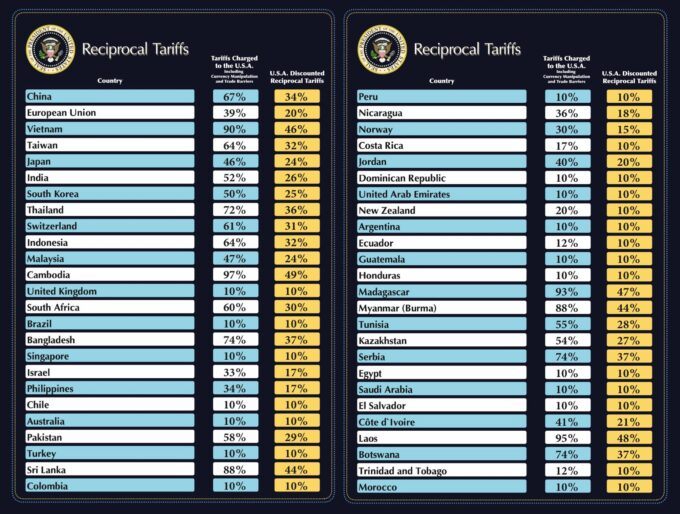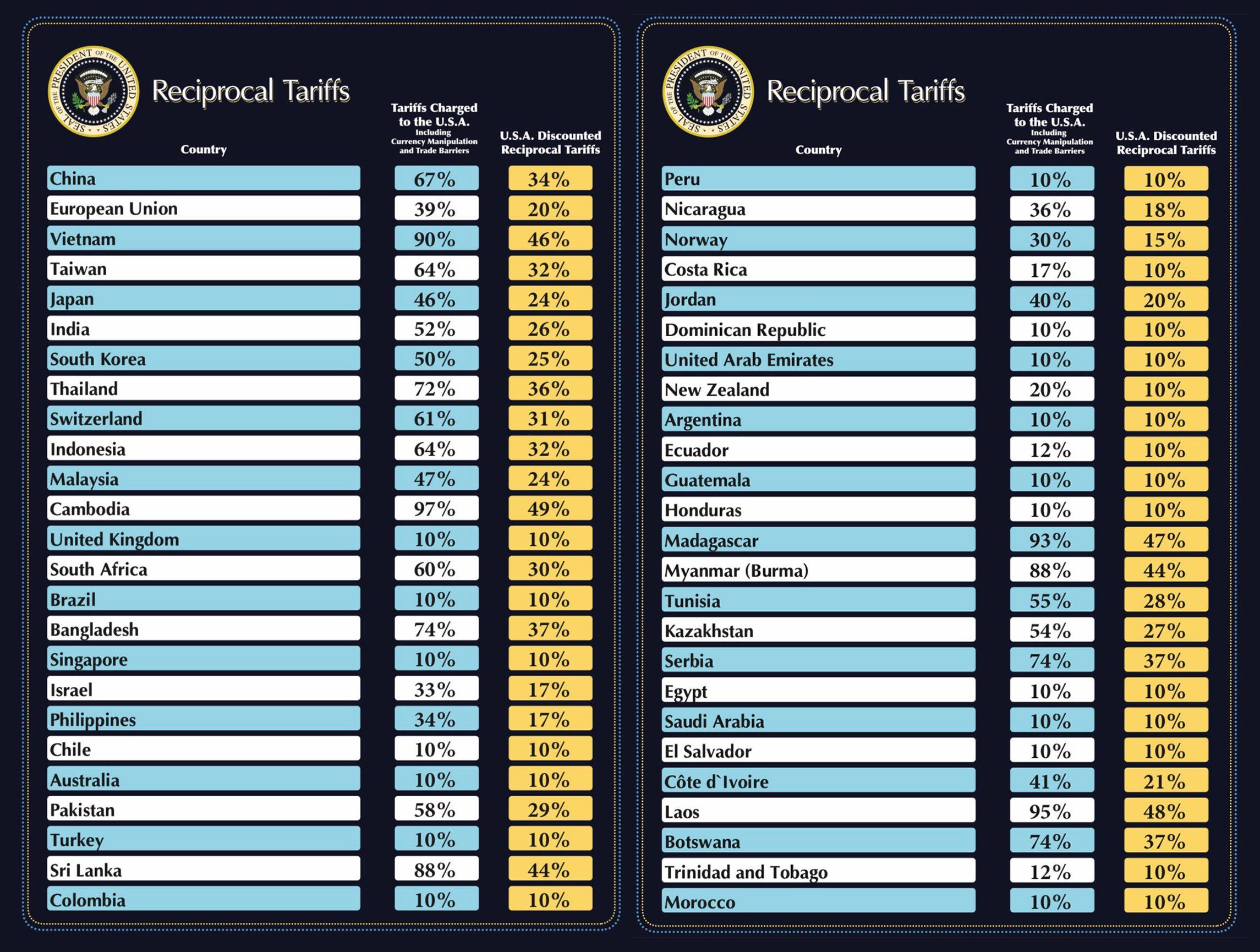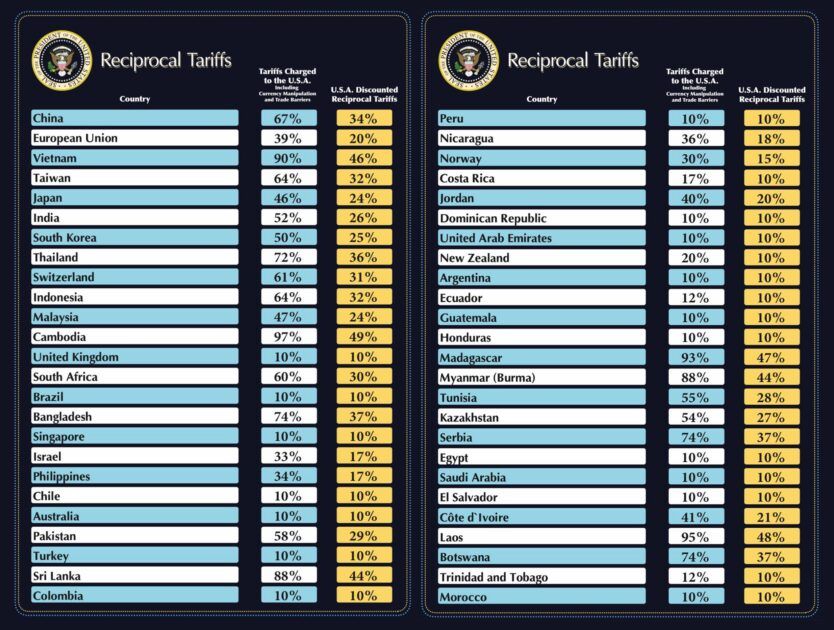






























































Work prepared by an officer or employee of the United States Government – Public Domain
President Donald Trump’s announcement of sweeping reciprocal tariffs, branded as “Liberation Day,” signals a tectonic shift in global trade dynamics. The plan, which enforces a baseline 10 percent tariff on all imports to the United States and imposes even steeper rates on specific trading partners, underscores his adherence to a twentieth-century economic worldview. In complete disregard of the intricate interdependence of the modern global economy, Trump’s perspective on trade is entrenched in a zero-sum game theory where one nation’s gain is perceived as another’s loss. This policy represents a stark departure from decades of U.S. trade strategy, which will certainly push key economic allies to resort to retaliatory measures.
The given rationale behind Trump’s tariff policy is that if a country levies a 10 percent tariff on American goods, the United States should reciprocate. However, this approach reflects a fundamental misapprehension of the mechanics of international trade. American manufacturers are heavily reliant on imported components for assembling final products. By inflating the cost of these inputs through tariffs, the competitiveness of U.S.-made goods in global markets will be significantly undermined. Moreover, a substantial segment of the American workforce is employed in export-driven industries—from agriculture to automotive manufacturing—that thrive on open markets. A retaliatory trade policy would inevitably provoke foreign governments to impose counter-tariffs on American exports, directly jeopardizing these industries and their workers.
The global response to this announcement has been overwhelmingly critical. Key U.S. allies, including members of the European Union, have already signaled their intent to retaliate. The EU, historically a robust U.S. trading partner, has hinted at imposing counter-tariffs on iconic American exports such as agricultural products, luxury goods, and automobiles. Such measures could cripple industries that are heavily reliant on foreign markets. Similarly, China, a frequent target of U.S. trade grievances, is preparing its own set of punitive tariffs aimed at critical American sectors like technology, agriculture, and aviation. Australia, a close trade and security ally of the United States, has condemned the move, arguing that it undermines the global trading system painstakingly constructed over decades. Brazil, a major exporter of raw materials, has also warned of destabilizing effects on global commodity markets and has indicated its readiness to explore countermeasures. These reactions suggest that instead of recalibrating America’s trade relations, the new tariffs could plunge the world into an escalating cycle of trade wars.
For American consumers, the repercussions of these tariffs will be palpable. With the United States importing approximately $3.3 trillion worth of goods annually, the new tariffs will impact nearly every sector. From electronics and clothing to automobiles and food products, the increased import costs will inevitably be passed on to consumers. This will result in rising prices across the board, eroding purchasing power and disproportionately affecting lower- and middle-income households. For instance, electronics reliant on Asian components could see sharp price hikes, making everyday items like smartphones and laptops significantly more expensive.
Take the automotive industry as an example. The automotive industry is likely to face a major price increase in the United States because Trump imposed 25 percent tariffs on imported vehicles and auto parts. The price of new cars may rise between $5,000 and $15,000 based on the specific model. Even if the cars are manufactured domestically, the majority of U.S. vehicle sales depend on imported components. The increased costs will be transferred to customers by automakers, which will result in higher prices for all vehicles sold in the market.
The ripple effects will extend beyond consumer goods. As manufacturers and retailers grapple with higher input costs, some may be forced to scale back operations or reduce hiring, leading to job losses, particularly in industries dependent on complex global supply chains. Ironically, the very American workers these tariffs aim to protect may bear the brunt of the fallout. The agricultural sector is also poised to suffer. Retaliatory tariffs from major importers of U.S. agricultural products, such as soybeans and corn, could devastate farmers already operating on razor-thin profit margins, further exacerbating economic disparities in rural communities. Historically, protectionist trade policies have often yielded unintended consequences, and this instance is unlikely to be an exception. The Smoot-Hawley Tariff Act of 1930, enacted during the Great Depression, triggered a wave of retaliatory tariffs from trading partners, leading to a sharp contraction in global trade and exacerbating the economic crisis. Although the current economic context differs, the risks remain analogous. Trade wars have no winners, and in today’s interconnected global economy, the fallout is rarely confined to the initiating country.
Beyond the economic ramifications, the geopolitical consequences of this policy are equally concerning. At a time when global challenges such as climate change, pandemics, and technological disruptions demand collective action, this unilateral U.S. approach risks alienating allies and undermining international cooperation. Nations that have traditionally looked to the United States for leadership may begin exploring alternative alignments, potentially shifting the global balance of power in ways that could have enduring consequences. Furthermore, these tariffs erode the rules-based international trading system that has underpinned global economic stability since World War II. By sidelining multilateral negotiations in favor of unilateral action, the United States sets a precedent that other nations may emulate, further fracturing the global trading order.
The economic rationale for these tariffs is deeply flawed. Trade imbalances are not solely the result of unfair practices by other nations; they are shaped by a complex interplay of factors, including currency valuations, domestic consumption patterns, and comparative advantages. Blanket tariffs fail to address these underlying issues and instead risk creating new challenges. Although certain industries may experience short-term relief, the long-term consequences are likely to outweigh any immediate gains. American exporters, facing retaliatory tariffs, will struggle to compete in international markets, potentially leading to job losses in export-dependent sectors and offsetting any benefits in protected industries.
The timing of this announcement adds another layer of complexity. With the global economy still reeling from the aftershocks of the COVID-19 pandemic, including persistent inflationary pressures and supply chain disruptions, introducing such a disruptive policy at this juncture risks exacerbating economic instability both domestically and internationally. It is a high-stakes gamble with potentially far-reaching consequences.
This first appeared on FPIF.
The post How Trump’s Tariffs are Driving the World Toward Economic Chaos appeared first on CounterPunch.org.
This post was originally published on CounterPunch.org.